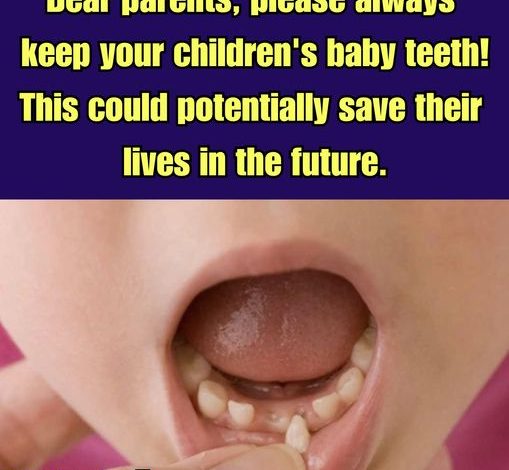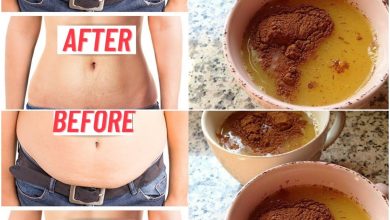
ADVERTISEMENT
Why Keeping Your Child’s Baby Teeth Could Save Their Life in the Future
ADVERTISEMENT
Introduction
Baby teeth have long been regarded as sentimental keepsakes, often saved by parents as cherished mementos of their child’s early years. However, recent scientific advancements reveal that these tiny teeth could serve a far more valuable purpose beyond nostalgia. Researchers have discovered that baby teeth contain stem cells, which have the potential to aid in medical treatments, tissue regeneration, and possibly even life-saving procedures in the future. Here’s a closer look at why you might want to consider keeping your child’s baby teeth and how they could be used to protect their health down the line.
1. The Science Behind Stem Cells in Baby Teeth
Stem cells are unique in that they have the ability to develop into different types of cells, making them incredibly valuable in medical research and regenerative medicine. They can transform into muscle cells, nerve cells, bone cells, and more. Stem cells are already being used in treatments for conditions like leukemia, lymphoma, and certain autoimmune diseases, and they hold promise for even more therapies in the future.
Baby teeth, specifically the pulp (the soft inner tissue) found in these teeth, are a rich source of mesenchymal stem cells (MSCs). MSCs are capable of regenerating bone, cartilage, and even muscle tissue. Since baby teeth are typically shed naturally between the ages of 6 and 12, they provide a painless and accessible way to collect these precious cells, which can be preserved for potential medical use later in life.
ADVERTISEMENT
2. Why Stem Cells from Baby Teeth Are Unique
The stem cells found in baby teeth are particularly valuable because they are younger and more “flexible” than stem cells collected from adults. Younger stem cells are generally more adaptable and have a greater ability to replicate, which makes them more effective for medical treatments. As we age, the potency of our stem cells diminishes, making early-collected cells from baby teeth more desirable for regenerative medicine.
Moreover, baby teeth stem cells are genetically matched to the individual from whom they were collected. This means that if your child ever requires a stem cell treatment, the cells from their baby teeth are a perfect genetic match, reducing the risk of rejection or complications compared to using cells from a donor.
3. Potential Medical Uses of Baby Teeth Stem Cells
Though research is still ongoing, stem cells from baby teeth have already shown promise in several areas of medicine:
ADVERTISEMENT
- Regenerative Medicine: Stem cells from baby teeth could be used to repair damaged tissues, such as those affected by injuries, degenerative diseases, or organ damage. They have potential applications in regenerating bone, cartilage, and even nerve tissues, which could be beneficial in treating conditions like arthritis, bone fractures, and neurodegenerative diseases.
- Diabetes Treatment: Researchers are exploring how stem cells from baby teeth can be used to regenerate insulin-producing cells, offering hope for individuals with type 1 diabetes.
- Heart and Brain Repair: Stem cells could play a crucial role in repairing tissues damaged by heart attacks or strokes. By regenerating healthy cells in these areas, stem cell treatments may reduce the lasting impact of these life-altering events.
- Immune System Support: In the case of severe infections or autoimmune diseases, stem cells may help restore or regulate the immune system. This application is still being studied, but early results are promising.
- Future Personalized Medicine: Stem cells from baby teeth can be preserved and multiplied in a lab, opening the door to personalized medicine. In the future, medical treatments might be custom-designed using a patient’s own cells, which would improve outcomes and minimize the risk of rejection or adverse reactions.
4. How to Preserve Baby Teeth Stem Cells
To use baby teeth stem cells for future treatments, they must be preserved in a controlled environment shortly after the teeth fall out. While storing teeth at home might seem convenient, home storage doesn’t provide the right conditions for preserving stem cell viability. Specialized facilities, known as stem cell banks, offer professional storage solutions designed to keep stem cells intact for decades.
Here’s how stem cell preservation typically works:
- Collecting the Tooth: When your child loses a tooth, it’s important to keep it intact, especially the inner pulp. The tooth should be handled carefully to avoid contamination and should not be dried out. Some stem cell banks provide collection kits to ensure safe transport.
- Transport to a Lab: Once collected, the tooth is sent to a specialized laboratory, where stem cells are extracted from the pulp and tested for viability.
- Cryopreservation: The extracted stem cells are stored through a process called cryopreservation, where they are frozen at extremely low temperatures. This keeps the cells dormant but viable, preserving them for future use. Cryopreserved stem cells can remain usable for many years, allowing families to access them if needed for medical treatments.
While the process does involve a cost, many parents see it as an investment in their child’s future health, especially given the growing potential of stem cell treatments.
5. The Ethics and Practicality of Stem Cell Banking
ADVERTISEMENT
Although stem cell banking from baby teeth is a relatively new concept, it’s gaining interest as regenerative medicine continues to advance. However, it’s important to weigh the costs and consider the ethical aspects of this decision.
Stem cell banks charge both a one-time processing fee and annual storage fees, which can be a financial consideration for families. Additionally, as with any medical field in its infancy, there are no guarantees that these stem cells will ever be needed or used. However, given the rate of progress in stem cell research, many parents feel that the potential benefits outweigh the costs.
In terms of ethics, using a child’s own cells poses minimal ethical concerns compared to stem cells derived from embryos. Since baby teeth are naturally shed, there’s no invasive procedure or harm involved, making this an ethical and accessible way to preserve stem cells.
6. Alternatives and Future Outlook
If you’re unable to store baby teeth, there are other ways to access stem cells, though they may not be as ideal. For instance, adult stem cells can be collected from bone marrow, but this procedure is invasive and the cells are not as potent as those collected from a child. Umbilical cord blood banking, which collects stem cells at birth, is another option that some parents choose.
Looking to the future, the field of regenerative medicine is expanding rapidly. As more research is conducted, the applications for stem cells will likely continue to grow, potentially impacting treatments for numerous conditions. Preserving baby teeth stem cells is a way to take advantage of these future advancements, providing a biological “insurance policy” that could one day help your child if they need it.
Conclusion
The idea of keeping your child’s baby teeth may seem unconventional, but science is showing that these tiny teeth contain a wealth of potential. With advances in regenerative medicine, the stem cells in baby teeth could become invaluable resources for treating a wide range of diseases and injuries in the future. For parents looking to safeguard their child’s health in every possible way, preserving these stem cells offers a unique and proactive option.
Though stem cell preservation involves a cost and some logistical planning, the potential benefits may make it a worthwhile consideration for many families. As we continue to explore the possibilities of stem cell therapies, keeping baby teeth could become a common practice, transforming these sentimental keepsakes into tools for healing and health. In a world where science constantly opens new doors, those tiny teeth may hold the key to a healthier future.
ADVERTISEMENT




